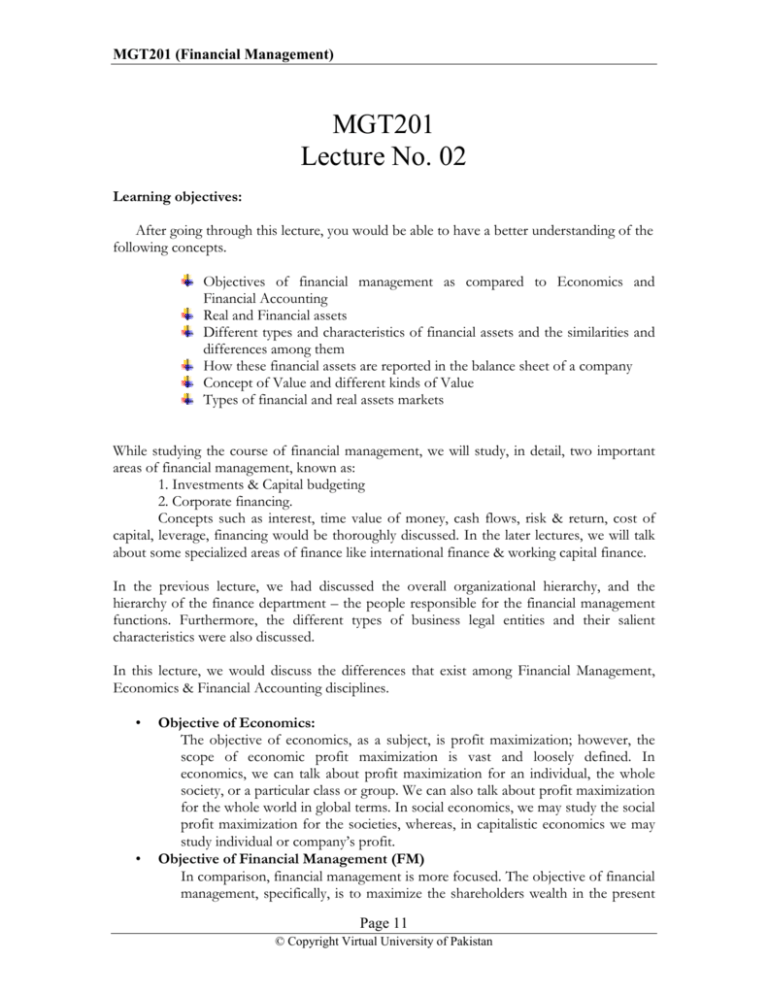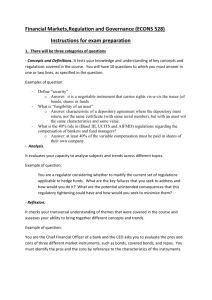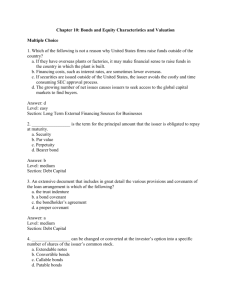MGT201 Lecture No. 02 - Learning Management System
advertisement

MGT201 (Financial Management) MGT201 Lecture No. 02 Learning objectives: After going through this lecture, you would be able to have a better understanding of the following concepts. Objectives of financial management as compared to Economics and Financial Accounting Real and Financial assets Different types and characteristics of financial assets and the similarities and differences among them How these financial assets are reported in the balance sheet of a company Concept of Value and different kinds of Value Types of financial and real assets markets While studying the course of financial management, we will study, in detail, two important areas of financial management, known as: 1. Investments & Capital budgeting 2. Corporate financing. Concepts such as interest, time value of money, cash flows, risk & return, cost of capital, leverage, financing would be thoroughly discussed. In the later lectures, we will talk about some specialized areas of finance like international finance & working capital finance. In the previous lecture, we had discussed the overall organizational hierarchy, and the hierarchy of the finance department – the people responsible for the financial management functions. Furthermore, the different types of business legal entities and their salient characteristics were also discussed. In this lecture, we would discuss the differences that exist among Financial Management, Economics & Financial Accounting disciplines. • • Objective of Economics: The objective of economics, as a subject, is profit maximization; however, the scope of economic profit maximization is vast and loosely defined. In economics, we can talk about profit maximization for an individual, the whole society, or a particular class or group. We can also talk about profit maximization for the whole world in global terms. In social economics, we may study the social profit maximization for the societies, whereas, in capitalistic economics we may study individual or company’s profit. Objective of Financial Management (FM) In comparison, financial management is more focused. The objective of financial management, specifically, is to maximize the shareholders wealth in the present Page 11 © Copyright Virtual University of Pakistan MGT201 (Financial Management) terms. Financial practitioners usually use the discounting and the net present value techniques while calculating the increase in the wealth of shareholders. • Objective of Financial Accounting (FA): The objective of financial accounting is to collect accurate, systematic, and timely financial data and other financial information, and to compile and consolidate it in an organized and systematic way, according to the principles and rules of accounting, for reporting purpose. The financial managers use these reports to assess the financial position of the company through various financial management tools and then the financial position can be compared to, or benchmarked against, the industry norms. The four different financial statements used for the purpose of reporting and analysis are 1. 2. 3. 4. Balance Sheet P/L or Income Statement Cash Flow Statement Statement of Retained Earnings (or Shareholders’ Equity Statement) In financial accounting, assets are recorded on the basis of historical costs in the balance sheet, i.e., the assets are recorded at their original purchase price. Of course, the depreciation on the asset is duly subtracted from its original value as the asset remains in use of the business. However, in financial management, book value is seldom used and financial managers consider the market value and the intrinsic value of assets. Market value may be defined as the value currently prevailing in the market or the value at which the sellers are ready to sell, and buyers are ready to buy a particular asset. Intrinsic value or the fair value is calculated by summing up the discounted future cash flows. In Financial accounting, we followed the principle of accrual accounting in which expenses & incomes are rerecorded when they incur. In Financial management, we will primarily be interested in cash & cash flows. In Financial management, we will use cash as primary source for calculating value, although the accrual data would also be useful for analyzing a firm’s financial position. Before getting into details, it is important to understand a few concepts that would be frequently used throughout the course. Real Assets: Real assets are tangible assets that have physical characteristics. For instance, land, house, equipment, car, wheat, fruits, cotton, computers, etc., are different kinds of real assets. Securities: Security, also known as a financial asset, is a piece of paper representing a claim on an asset. Securities can be classified into two categories. Page 12 © Copyright Virtual University of Pakistan MGT201 (Financial Management) • Direct Securities: Direct securities include stocks and bonds. While valuing direct securities we take into account the cash flows generated by the underlying assets. Discounted Cash Flow (DCF) technique is often used to determine the value of a stock or bond. • Indirect Securities: Indirect securities include derivatives, Futures and Options. The securities do not generate any cash flow; however, its value depends on the value of the underlying asset. While in this course, direct securities would be discussed at length, the indirect securities would only be skimmed through in the later chapters. Bonds: • • • • Bonds represent debt. The important features of bonds are given as under. Internationally, bonds are the most common way for companies to raise funds. A bond is a long-term debt contract (on paper) issued by the borrower (Issuer of the Bond i.e., a company that wishes to raise funds) to the lenders (bondholders or Investors which may include banks, financial institutions, and private investors). Bonds issued by a company are usually shown on the liabilities side of the Balance Sheet. A Bond requires the borrower to pay a pre-determined amount of interest regularly to the lender (bondholder). The interest rate or the rate of return on a bond can be Fixed or Floating. If an investor purchases a bond which is offering a rate of 10 % for the life of the bond, the rate would be fixed at 10 percent. However, if the interest rate on the bond is tied to the market interest rates, the rate of interest would be floating. The floating rate implies that the interest rate would fluctuate with any change in the market interest rate. Types of Bonds: • Debentures: • Mortgage Bond: • Others: Unsecured – no asset backing Secured by real property i.e. Land, house Eurobond, Zeros, Junk, etc. The details on these different types of bonds would be discussed in later lectures. Stocks (or Shares): Stocks (or Shares) are paper certificates representing ownership in a business. Therefore, if a company has issued 1 million shares and an investor owns 1 share only, he is a part owner (or shareholder) of the company. Stocks or shares are represented in the equity section of the balance sheet. A stock certificate is perpetuity, i.e., it lasts as long as the company does. Shareholders have a residual claim (last claim) on whatever net income (or profit) and assets are left over after the bondholders have been fully paid off. It is the most common source of raising funds under Islamic Shariah. Shares are traded in Stock market e.g. Karachi Stock Exchange (KSE), Lahore Stock Exchange (LSE) & Islamabad Stock Exchange (ISE). Page 13 © Copyright Virtual University of Pakistan MGT201 (Financial Management) Difference between Shares & Bonds: The main difference between shares and bonds is that shares are representation of ownership in a company while bonds are not representative of ownership. The second difference is that shares last as long as the company lasts where as bonds have limited life. Another difference is that the return on a bond is predetermined, i.e., the investor knows in advance how much return he would get from a bond. However, a stockholder cannot be certain about the return on a stock investment, since the dividends may or may not be paid in a certain year or the percentage of dividends announced may vary. Types of Stocks (or Shares): Common Stock: Common shareholders receive dividends, or portion of the net income which the management decides, NOT to reinvest into the company in the form of retained earnings. Dividends are paid in proportion to the number of shares the stockholders own and are announced by the board of directors, who may opt not to announce a dividend in a particular year. Common Stockholders have voting rights to elect the board of directors. Preferred Stock: It is the stock with a predetermined or fixed dividend. In case, the board of directors announces dividends, the preferred stockholders would have a priority claim on them, i.e., they would be paid dividends before any dividends are paid to the common stockholders. However, if the board opts to retain earnings, the preferred stock would not yield a dividend, and thus cash flows from a preferred dividend are not as certain as income of the bondholders. Dividends are paid out of net income. Shareholders get a part of the net profit of the company during the year, proportional to their shareholdings, and it is for the management to decide how much of the profit is to be distributed among the shareholders. Now, we will see how these shares and bonds will appear on the face of a balance sheet. We will have to look at these shares and bonds from two aspects, the shares and bonds that the company issues and the shares and bonds that company invest in. The shares and bonds that a company purchases as an investment will come on the asset side under the section of marketable securities. These shares and bonds have been purchased by the company to generate extra income. On the other hand, those shares and bonds that the company issues to raise funds will appear on the liability side. If the company has issued bonds, they will be classified as liability. But if the company has issued equity shares, they will appear under the section of common equity on liability side in the balance sheet. Page 14 © Copyright Virtual University of Pakistan MGT201 (Financial Management) Where do bonds & stocks appear on the Balance Sheet? Stocks & Bonds Purchased as Investment Own Bonds issued by company to raise cash Own Stock issued by company to raise cash Finally, let’s talk about the most important concept that we will keep on repeating throughout the course; the concept of ‘value’. In financial terms, there are different types of values, which are given as under. Value • Book Value: Book Value is the value of an asset as shown on the Balance Sheet. It is based on historical cost (or purchase price) and accumulated depreciation. • Market Value: Market value of an asset is as quoted in the market, which basically depends on the supply & demand of the asset and the negotiations between buyers & sellers. Page 15 © Copyright Virtual University of Pakistan MGT201 (Financial Management) • Liquidation Value: The liquidation value is the value of an asset in a particular situation, where the company is in the process of wrapping up the business and its assets are valued and sold individually. • Fair Value or Intrinsic Value: The most important value concept in this course is of fair value or the intrinsic value. In order to find the intrinsic value of an asset, the present value of the working assets’ future cash flows is calculated and summed up. If the intrinsic value of an asset is less than its market value, the asset among investors is perceived as “undervalued”. Financial Markets • Capital Markets: These are the markets for the long term debt & corporate stocks. The maturity of debt should be more than one year to qualify it as a capital market instrument. Stock Exchange: A stock exchange is a place where the listed shares, Term finance certificates (TFC) and national investment trust units (NIT) are exchanged and traded between buyers and sellers. Long term bonds: Long term government & corporate bonds are also traded in capital markets. • Money Markets Money market generally is a market where there is buying and selling of short term liquid debt instruments. (Short term means one year or less).Liquid means something which is easily encashable; an instrument that can be easily exchanged for cash. Short term Bonds o Government of Pakistan: Federal Investment Bonds (FIB), Treasury-Bills (T-Bills) o Private Sector: Corporate Bonds, Debentures Call Money, Inter-bank short-term and overnight lending & borrowing Loans, Leases, Insurance policies, Certificate of Deposits (CD’s) Badlah (money lending against shares), Road-side money lenders Page 16 © Copyright Virtual University of Pakistan MGT201 (Financial Management) • Real Assets or Physical Asset Markets o Cotton Exchange, Gold Market, Kapra Market o Property (land, house, apartment, warehouse) o Property (land, house, apartment, warehouse) o Computer hardware, Used Cars, Wheat, Sugar, Vegetables, etc. Page 17 © Copyright Virtual University of Pakistan








